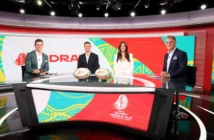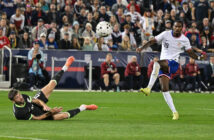
Sounder-down-Under is a look at the beautiful game from the other side of the world, written by Seattle ex-pat Drew Dickson.
Like many nations in the world, Australia has a strange and at times strained relationship with its First Peoples. As it is for many indigenous/aboriginal people, sport is not only a symbol of expression, but also gives them a chance to escape a life below the designated United Nations poverty lines.
This week, soccer in Australia took a step forward in recognizing their Indigenous people by bringing young kids from some of Australia’s remote Aboriginal communities to experience the beautiful game. Like their counterparts in Australian Rules Football, Football Federation Australia along with the A-League are taking steps forward in order to ensure that soccer is open to anyone with a desire to play, and I commend them for it.
This week of soccer was designated Indigenous Football Week and launched by John Moriarty, the first Aboriginal Australian selected to wear the green and gold for Australia. As a youth he played for clubs in Adelaide before being requested by his nation to wear the colors for a trip to face off against fellow Commonwealth nation Hong Kong in 1960. Sadly, the trip would be cancelled when FIFA suspended Australia for poaching players for the national team that were not eligible. The irony in this cannot be lost on John Moriarty.
His father was Irish from County Kerry while his mother was a full blooded Aboriginal woman from the Yanyuwa people in the Northern Territory. At the age of four, as he was not considered to be an Australian, due to being designated a “half-caste”, the Australian government, as per their policy at the time, removed him from his family.
In Australia, the people were affected by this policy are known as the Stolen Generation. With the removal of children from their communities a break was created between culture and child, leaving many languages dying out and a cycle of mistrust between communities and all forms of government.
Between 1905 and 1969 (though there is evidence that removals occurred well into the 1970s) Aboriginal children were taken from their parents under the guise of ensuring their population would not suffer decline from contact with European Australians, misplaced fear of child abuse, and a fear of miscegenation of full blooded Aboriginal people. In the end, the reasons gave way to the truth; that white society at the time was not ready to accept Australia’s First People as equals, much less see children who were of mixed descent walk among them.
Young John Moriarty spoke no English at age four, only his Yanyuwa language. This would be changed as he was taken to Mulgoa, a home for Aboriginal children in the West of Sydney, before being moved once more to Adelaide. Friday night’s clash with Central Coast Mariners taking on Western Sydney Wanderers, playing in a stadium just under ten miles away from where the man whose name the Round has been named after was first taken to as a child. The homes, schools, and Christian boarding schools were a mixed bag of finishing schools for household servants, hunting ground for sexual predators, and buildings where misguided Australians thought their work was saving the souls of poor children who had fallen out of favor of God by not being born white.
Upon Australia’s declaration of Federation in 1901, the nation had a population that consisted of a large majority of people from European descent and some Asian immigrants. Missing from the declaration was any mention of the Aboriginal people who predated contact as citizens of this new land. In fact, they were classified under the flora and fauna.
When John Moriarty was born, he was considered half-human. When he was asked to represent his country, he was half-human in the eyes of the population. It would not be until 1962 before he would be allowed to vote, and not until 1967 before Australia would legally recognize their first Aboriginal Socceroo as a man and a citizen. Finally, in 2007, Australian Prime Minister Rudd would look into a camera and formally apologize to the Australian Aboriginal community as a whole for the Stolen Generation and the role of the government during the time.

Photo Credit: Kari Heistad
The week started out with a 5-1 thrashing of Jordan as the Socceroos pushed themselves closer to a trip to Russia for the 2018 World Cup and league matches on the weekend with Aboriginal youth acting as escorts for the players. Though none were born at the time that John Moriarty plied his trade on the pitch, they have witnessed another Aboriginal man, Brisbane Roar’s Jade North wearing the captain’s armband for his nation in international competition and an Aboriginal woman, Boston Breaker’s Kyah Simon, be the first person of Australian Aboriginal descent (male or female) to score in a World Cup.
Many of the youths who escorted their playing legends on to the pitch made the trip from Northern Territory to Adelaide on their first plane flight, some as young as eight, others as old as sixteen. This might not seem like a major life event, but in a country like Australia, to NOT fly once a year is very odd. The second most taken daily flight in the world is Melbourne-Sydney (number one is New York-LA).
This in itself highlights the disconnect that many in the whole of Australian society see with the First People as like so many other indigenous groups are marginalized by the larger aspects of society, living on the fringes and still more a part of legend than of reality.
To readers in the United States, our government is guilty as well. We too had adopted policies of sending Native children to boarding schools of much the same nature as Australia, the idea being to “Kill the Indian to save the man.”
It would not be until 1924 before the Snyder Act would give the Nations acknowledgement as citizens of the United States, despite the Fourteenth Amendment of the Constitution. Boarding schools would remain in affect, but unlike the Australian model, after being told their entire way of life was wrong, the children would be returned to their reservations to bring back European/American ways to their people. All this did was serve to break up families and in the formative years of a child, break a bond between them and their parents.
Today, statistics show that reservation born children face double and in some cases triple the chance of incarceration, substance abuse, spousal abuse, and sexual abuse, than that of their fellow Americans of other ethnic groups in both rural and urban homes.

Chris Wondolowski’s passion will not diminish because San Jose cannot qualify
John Hefti
Like in so many small ethnic groups, if there is one person doing well in a sport, the whole community will support him. For soccer and Native Americans, that man is San Jose Earthquakes striker Chris Wondolowski, member of the Kiowa Nation. Temryss Lane of the Lummi Nation balances her time between Fox commentating and the club Ajax America Women in the second tier Womens Professional Soccer League in the U.S. They have been pillars of their own communities and shown a light on to a people who in my own eyes deserve more recognition within American society and sport.
![Prost International [PINT]](https://prostinternational.com/wp-content/uploads/2021/08/PINTtFontLogoRoboto1536x78.jpg)


